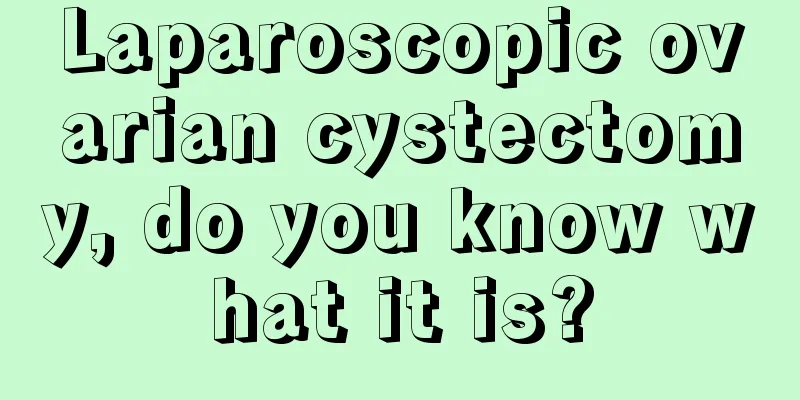Laparoscopic ovarian cystectomy, do you know what it is?

|
Ovarian cyst is a common gynecological disease in women. The ovaries are important reproductive organs in women. Once damaged, it is likely to cause infertility, which is extremely harmful to women. Therefore, it is necessary to deal with it in time and receive treatment. Laparoscopic ovarian cystectomy is an effective means of treating ovarian cysts. So what is it? Surgical procedure: Materials to be prepared: laparoscopic instruments, conventional instrument kits, pneumoperitoneum machine, flushing pump, suction device Indications: Ovarian tumor-like lesions, benign ovarian tumors Anesthesia: General anesthesia Surgical incision: below the umbilicus, at McBurney's point on the right side and the corresponding point on the left side Body position: supine Surgical procedures: 1. Routine disinfection, laying sterile sheets 2 Connect the imaging system, cold light source (connected with a sterile clean cover), pneumoperitoneum machine, single and double poles, suction device, flushing pump, uterine suspension machine 3. Disinfect the skin with alcohol cotton balls, lift the abdominal wall with 2 towel clamps, make an incision with a No. 11 blade, insert the pneumoperitoneum needle into the abdominal cavity, withdraw the 5ml needle, and after inducing pneumoperitoneum, puncture with a large prong, remove the needle core, connect the pneumoperitoneum, retract the pneumoperitoneum needle and put it away, insert the lens for observation, and remove the towel clamp. 4 Disinfect the skin with alcohol, make the second and third incisions under endoscopic monitoring, and puncture with a small needle. 5. Use curved forceps to lift and clamp the ovary, and use a single-stage hook to make a longitudinal incision on the ovarian capsule. 6. Use non-destructive forceps to separate the gap between the ovary and the cyst wall, and use bipolar electrocoagulation to stop bleeding. 7 If it is a large ovarian cyst, you can connect an aspirator to suck out the fluid in the cyst cavity and use the curved forceps to remove the cyst skin. 8 Bipolar electrocoagulation to stop bleeding, rinse the wound with saline, and check for bleeding 9 Release the carbon dioxide in the abdominal cavity, count the items, retrieve and put away the laparoscopic instruments 10 Disinfect with alcohol cotton balls, suture the wound with 3-0 absorbable sutures, and apply a bandage |
<<: What are breast fibroids? What are the causes of breast fibroids?
>>: Women's care: What to look for after ovarian cyst surgery
Recommend
Women's risk of heart disease increases: Six types of people should pay special attention
Statistics show that women are increasingly susce...
Is it hard to find the "blood trace"? The great detective of upper gastrointestinal bleeding will teach you how to find the "troublemaker" in your body!
Author: Yan Liping, Fifth Medical Center, PLA Gen...
What to prepare after pregnancy?
Our female friends will all become mothers one da...
What to do if there is blood in the vagina after IUD insertion
IUD insertion is an effective long-term contracep...
Things to note when you are 35 days pregnant
Many new mothers don’t know what to pay attention...
How to regulate the stomach and intestines of pregnant women
The diet during the confinement period should be ...
Can I eat yogurt during my period?
Women's diet during menstruation should be li...
What causes liver pain in girls
In my country, the morbidity and mortality rates ...
What is the happiness of life?
Leviathan Press: "Don't have too many ex...
Food Misconceptions
Popular Science on Food Misconceptions: Future Ag...
Is a 14mm uterine fibroid serious?
The female urinary system is composed of the uter...
One case of a mutant strain that is of particular concern has been discovered in the country. Is the second round of the epidemic about to begin quietly?
Recently, the Chinese Center for Disease Control ...
How to regulate diet for women with positive gonorrhea?
Everyone should know that a positive gonococcal t...
How long after taking the ovulation injection should I have sex?
How long should you wait after taking the ovulati...









